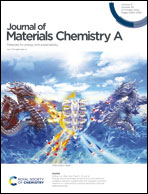Computational chemistry-assisted design of a non-fullerene acceptor enables 17.4% efficiency in high-boiling-point solvent processed binary organic solar cells†
Abstract
Designing new high-performance non-fullerene acceptors is the key driving force for the development of organic solar cells (OSCs). In this work, a new acceptor, BOEH-4Cl, was designed based on the end-group chlorination of L8-BO. Theoretical calculations successfully predicted the expected experimental results based on the optoelectronic properties of BOEH-4Cl and L8-BO and intermolecular interaction of PM6/BOEH-4Cl or L8-BO. A high-boiling-point solvent (HBPS, chlorobenzene) was also introduced as a calculation factor, which is beneficial to future industrialization. In agreement with the calculated results, the optimized HBPS-processed BOEH-4Cl film exhibited tighter molecular packing, a more efficient interfacial hole transfer process and lower non-radiative energy loss, demonstrating necessary properties as a promising acceptor. The efficiency of optimized HBPS-processed PM6/BOEH-4Cl OSCs reached 17.4%, much higher than that of PM6/L8-BO (14.5%). Hence, this work demonstrates the great potential of utilizing theoretical chemical calculations to assist in the design of acceptor molecules to reduce time and cost.



 Please wait while we load your content...
Please wait while we load your content...